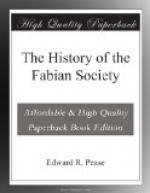During these later years the Fabian Society with its increased numbers was entitled to several delegates at the annual conference of the Labour Party, and it frequently took part in the business by putting motions or amendments on the agenda paper. All talk of forming a Fabian Socialist Party had died away, and the Executive Committee had shown itself far more appreciative of the importance of the Labour Party than in earlier years. I continued to represent the Society on the Executive Committee until the end of 1913, when I retired, and the new General Secretary, W. Stephen Sanders, took my place. When in December, 1915, he accepted a commission for the period of the war, as a recruiting officer, Sidney Webb was appointed to fill the vacancy.
* * * * *
The account of the part taken by the Society in the work of the Labour Party has carried us far beyond the period previously described, and a short space must now be devoted to the years which intervened between the Education episode and the outburst of activity to be described in the next chapter.
Social progress advances in waves, and outbursts of energy are always succeeded by depressions. Up to 1899 the Society slowly grew in membership until this reached 861. Then it slowly declined to 730 in 1904. This was symptomatic of a general lack of interest in Socialism. The lectures and meetings were poorly attended, and the really important debates which decided our educational policy were conducted by only a few dozen members. Twenty years had passed since the Society was founded. Of the Essayists Bernard Shaw, Sidney Webb, Hubert Bland, and when in England, Sydney Olivier were still leaders of the Society, and so until January, 1904, was Graham Wallas, who then resigned his membership on account of his disagreement with the tract on Tariff Reform, but really, as his letter published in “Fabian News” indicated, because in the long controversy over education policy he had found himself constantly in the position of a hostile critic. It should be added that his resignation has been followed by none of those personal and political disagreements which so commonly accompany the severance of old associations. Mr. Wallas has remained a Fabian in all except name. His friendship with his old colleagues has been unbroken, and he has always been willing to assist the Society out of his abundant stores of special knowledge both by lecturing at its meetings and by taking part in conferences and even by attending quite small meetings of special groups.
In all these years a large number of younger members had come forward, none of them of quite the same calibre as the Essayists, but many of them contributing much to the sum total of the Society’s influence. Of these perhaps the most active was Henry W. Macrosty,[33] who sat on the Executive from 1895 till 1907, when he retired on account of the pressure of official duties. During and indeed before his period of




